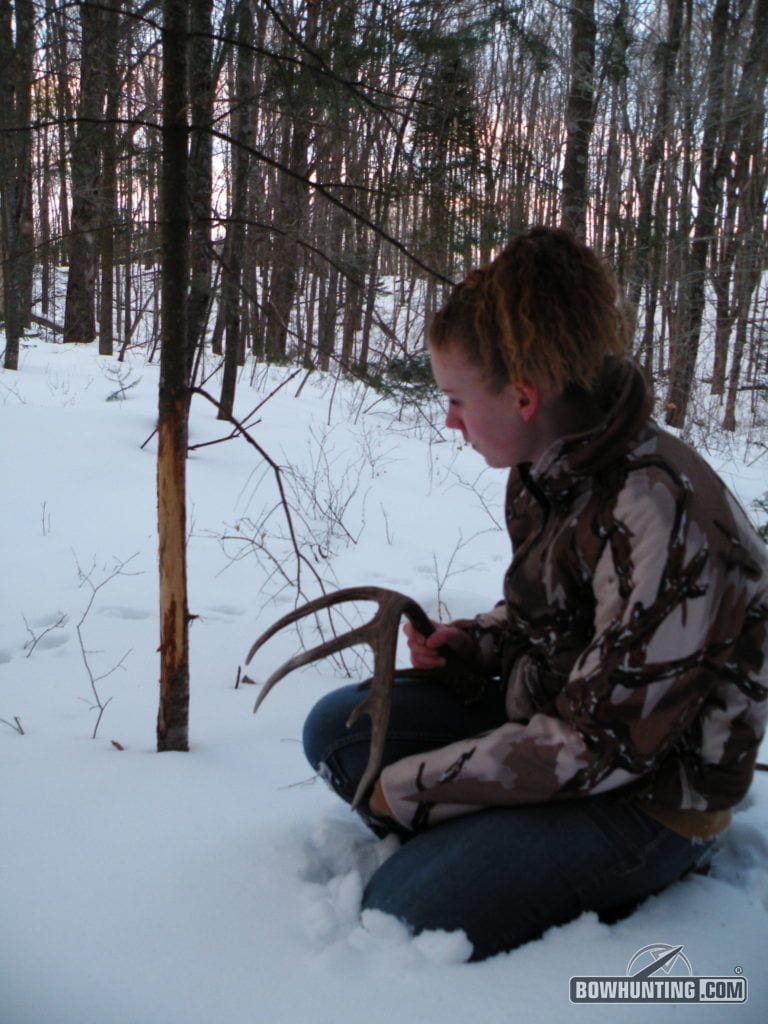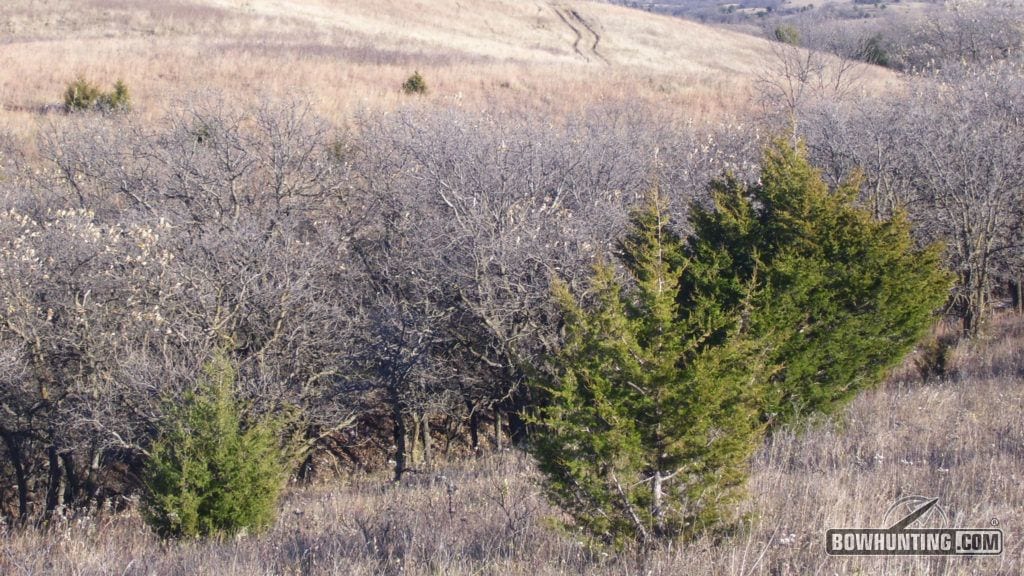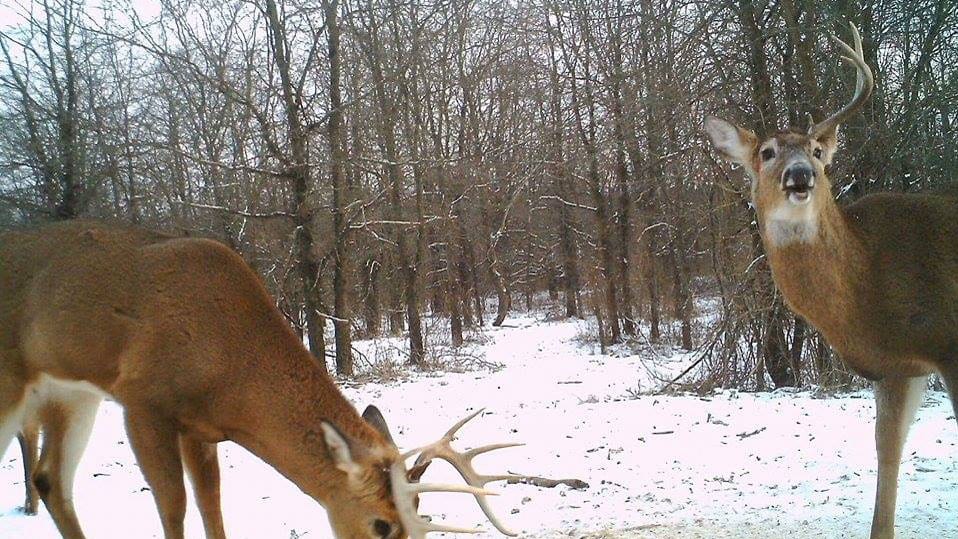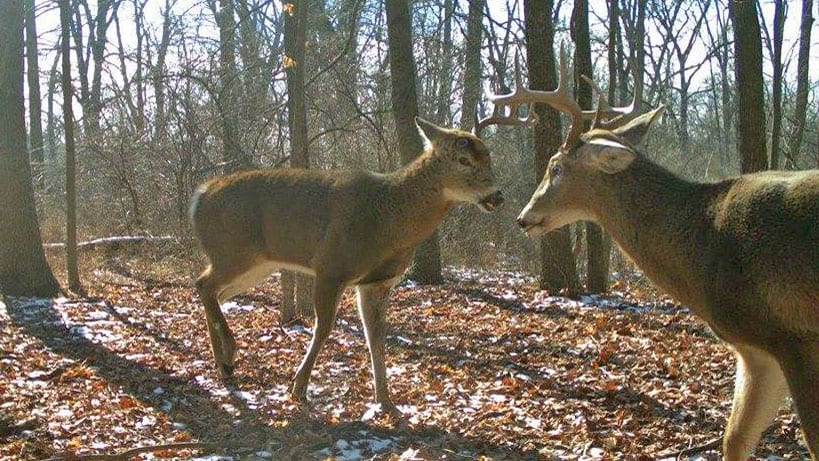If you’re a serious bowhunter, the time between whitetail season’s end and turkey season’s onset is an excellent time to walk your hunting turf. It helps you learn more about the land, its topography and the

Shed hunting is an excellent way to teach young people about the outdoors. It creates opportunities to explain hunting strategies and how deer sign helps you choose the ultimate ambush.
bucks that roam it. Now is the time to hit the woods…It’s shed hunting season!
Shed-Hunting Motives
Some bowhunters shed hunt solely to find antlers. That’s perfectly fine, and if your hunting grounds are loaded with them, I don’t blame you; I’m as fascinated by antlers as anyone. However, more can be gleaned from a shed outing than mere bone.
For example, shed hunting immediately following the spring melt can reveal leftover rut sign such as rubs and scrapes. Finding this sign and comparing it with topo maps and aerial imagery can help you formulate a killer ambush for next fall.
Shed hunting also creates opportunities to introduce children or your spouse to the woods. I’ve occasionally taken my wife and younger siblings shed hunting, and it makes the search more exciting. You can take them into your hunting areas and explain why you chose a particular stand location, or why you positioned your trail camera on a specific tree. Overall, it’s a low-impact approach to introducing people to the outdoors.
Another reason to hunt sheds is physical fitness. I’ve hunted sheds in some of South Dakota’s most unforgiving terrain. It’s hard work. Most bowhunters might not think this sounds fun, especially those who already have demanding jobs. However, every bowhunter can benefit from physical fitness, and there’s not a better way to kick off your fall fitness preparation than by conditioning your legs and augmenting lungpower via shed hunting.

Shed hunting in canyons and deep draws like these is taxing – a great way to stay in shape during the offseason.
Now, let’s review several considerations that’ll help you hunt sheds like a pro.
Go Now!
Shed hunting is a race; you’re not the only gatherer looking for them. Varmints ranging from mice to porcupines to coyotes seek nutrition from antlers. If you wait too long to go, you’ll find fewer antlers, and many you do find will have gnaw marks on them.
Whitetail bucks drop their antlers at slightly different times across their home range. For example, Northern-Wisconsin bucks routinely begin dropping antlers late in December and the first part of January. In states like Texas and Louisiana, archery season is far from over in December, and bucks commonly carry their crowns until February or March and even later in some cases.
Shed master Gary Reissmann hits the woods hard from the end of February until green up. “During this period, I try to hit several states and spend lots of time in the woods,” he said.
Reissmann, who’s already picked up three sheds this year, gets the lowdown on bucks’ whereabouts and the antler drop by utilizing trail cameras. “Using cellular trail cameras plays huge into my shed-hunting success,” he said. “Finding food sources and setting up cameras is key – you might need several cameras depending on the food source’s size. Then, I locate bedding areas and set up more cameras. This helps me monitor bucks when they leave the bedding area and again when they arrive at the food source, or vice versa. It eliminates many miles of walking and decreases time spent looking in each area. Nothing excites me like seeing a buck on camera with both antlers, then capturing him on another camera a half-mile away with one missing,” Reissmann continued. “Using cellular cameras also keeps me out of bedding areas so I don’t blow bucks out of the area before they’ve dropped their antlers.”
Like Reissmann, you can boost your odds by utilizing cellular cameras that deliver most recent info. Still, when it all boils down, sheds are where you find them.

Trail cameras located in and around food sources will help determine when the time is right to pick up sheds on the farms you hunt. (Photo courtesy of Gary Reissmann)
Places to Look
My brother, Joe McDougal, once happened upon several deer in Wisconsin while snowmobiling. When the deer scattered, he noticed a small buck in the group dropped an antler. He throttled over and picked it up.
Unfortunately, finding sheds is rarely so easy. I’ve trekked miles all over God’s great outdoors without finding a single shed. Other times, I’ve found multiple antlers within minutes of one another. I’ve concluded that you’ll most likely find them in specific areas.
Reissmann noted that location is imperative to finding big sheds. “In order to consistently find large antlers, you must look in states where big bucks live,” he said. “As far as exact locations, I probably find most of my largest sheds near food sources. There, bucks spar and chase one another around, which causes loose antlers to drop.”

This image exemplifies the role trail cameras play in shed-hunting success. (Photo courtesy of Gary Reissmann)
While walking public lands during shed season is helpful for crafting fall hunting strategies, Reissmann suggests finding sheds on them is difficult. “Shed hunting on public land is extremely tough,” he said. “I try to avoid pressured areas, or at least hit them during early morning hours. “Using cameras helps, but some hunters are disrespectful and tamper with them. Finding sheds on public property is more a stroke of luck than anything.”
On the South Dakota prairies, Joe McDougal annually picks up approximately 100 antlers, sometimes more. He finds many in wide-open fields where deer feed. Once he’s covered fields, he heads into canyons and deep draws where deer bed and travel. Western deer travel great distances between necessities, so antlers are typically more spread out. However, excellent buck densities make up the difference.
The Coveted Matched Set
Finding a matched set is every shed hunter’s dream. I’ve only found one matched set, and it was from a 1 ½-year-old 8-pointer. I’ll admit I was really jacked up to find them.
Reissmann told that finding both antlers from a mature buck can be extremely difficult. “Bucks become very wise once they reach 5 years of age,” he said. “If I do get lucky and find a set, its often in a bedding area, and usually within feet of the buck’s bed. Again, cellular cameras simplify the hunt for a crown.”
Other Things You See
Shed hunting amuses me for reasons beyond an antler haul. For example, while shed hunting with my brother, Marc McDougal, in March 2015, he found a spike-horn buck skull. We also witnessed a gobbler fight, a ruckus that consisted of aggressive purrs and gobbling for several minutes. We left the woods wide-eyed, and that was the first piece of the puzzle that led to Marc arrowing a beautiful gobbler a few weeks later.
On another occasion, I located a dead 3 ½-year-old buck while shed hunting a 70-acre parcel in Northern Wisconsin. I’d captured the buck on my trail camera as a 2 ½ year old, so I knew him well. I couldn’t pinpoint the cause of death, and strangely, the frozen buck’s neck was twisted around and his antlers were wrapped around his midsection. I’ll never know how he ended up in the peculiar position. I contacted the authorities and obtained a permit to retrieve his 135-inch antlers. It wasn’t the way I planned to collect them, but I’m sure glad I found him.

Author Darron McDougal found this dead buck while shed hunting in Wisconsin. The cause of death and the reason the buck’s antlers are wrapped around the body remain unknown.
Fall Prep Starts Now
Undoubtedly, walking your hunting grounds searching for sheds is a great way to learn your property and how deer use it, and hopefully gather some antlers. Get out in the coming weeks, and give it a shot. It might help you piece together the big-buck puzzle so you can plot a killer setup this fall.

 By
By 



